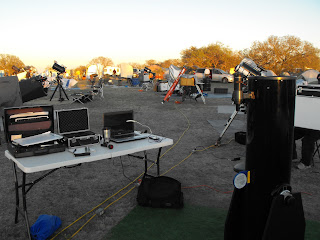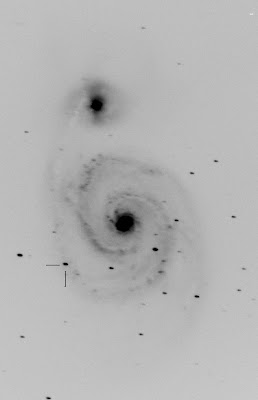The Hodges Garden Star Party is the week after next and I thought it would be appropriate to discuss just how I prepare for a star party. I have found over the years that in order to maximize your experience at a star party, you need to be very well prepared. Preparation not only takes the form of the equipment that you will take, but also what you want to observe while at the party.
Hodges Garden is a little unique as this will be the first time I that I have attended this event. So I started my preparation by a careful review of the
website. This particular star party is hosted by the Baton Rouge Astronomical Society. It is held at Hodges Garden State Park in west central Louisiana. The party is held from March 30th through April 3rd. There are limited facilities and as stated on the website, "camping is at its most basic."
A quick look at
Clear Sky Clock for a nearby site shows that the site has reasonably dark skies with a Bortle rating of 3. The clear sky clock also shows that humidity is a potential issue after midnight on most nights. This is important, as the observing site does not have electricity on the observing field. This means no hair driers to fight the dew. Luckily for dob owners, dew is not much of a problem except for the finder scopes and eyepieces.
The absence of electricity is important as I normally rely on my lap top for star charts and observing lists. So, it looks like I will need to plan on printing out my observation lists and bringing my Sky Atlas 2000. I will also bring both volumes of The Night Sky Observer's Guide. This is a really good reference for those faint fuzzies that I am hoping to see.
So, that brings us to figuring out what to observe. I am always torn between quantity and quality of the observations. Do I try and log as many objects as I can, or do I stop and spend quality time with each object, perhaps even sketching them. I do not have a great answer for this, and this is probably why I still struggle. I will say, that the answer depends on the weather forecast. If the weather looks good and I will get multiple nights to observe,then I am more likely to take my time with each object. If the forecast shows that there will be a limited window for observing, then I will typically go for quantity.
There was not a mention of an observation list on the website, so I guess I need to develop my own. As I have been working on the H400 list, it makes sense to see what damage I can do on that list. Utilizing my charting software, Cartes du Ciel, I look to see what is going to be visible from 8PM to 1AM. I utilize a 5 hour window as I usually fade pretty fast after midnight unless the viewing is truly spectacular.
The other criteria that I use when deciding what to view is the altitude of the object. I want to observe objects when they are at least 30 degrees above the horizon as this reduces the air mass that I am looking through. Now some of the southern objects will not meet this criteria, but I will just plan on observing them when ever they reach the zenith.
So as I look at the possibilities there are two groups that become evident. The first group is the H400 objects in Mon, Pup, CMa, and Gem. There are 33 objects still on my list. These objects are primarily open clusters embedded within the Milky Way. I think that this list will be achievable if I get 2 good nights to observe.
The second group consists of mostly galaxies in constellations that will be rising through the evening, Leo, UMa, Hya, Sex, Crv, Crt, Vir. There are a lot, 112 to be exact, of objects that are still on my list in these constellations. I think observing some of these should be on the list as they should really shine at this dark site. Now, I can't get everything, so I need to pare the list down to just a couple of constellations. Hya, Crv and Crt just have 1 object a piece left on the list, so I should go and get these out of the way. Leo has 18 left on the list and it will be pretty high in the sky most of the night and so I will include it.
So, now I have my completed list. 54 objects in total. If I get 4 nights of good weather, then it should be doable. If I get less than four nights, then my strategy will be from the top down as there will be other nights in April and May that I could use to get the objects at the bottom of the list.
NGC
RA
RA
Dec
Dec
Tp
Con
Mag.
2204
6
13.5
-18
35
OC
CMa 9.1
2215
6
18.4
-7
16
OC
Mon
8.6
2232
6
24.1
-4
43
OC
Mon
4
2244
6
29.7
4
54
OC
Mon
6.2
2251
6
32
3
24
OC
Mon
8.5
2264
6
38.4
9
56
EN
Mon
4.7
2286
6
45.1
-3
7
OC
Mon
8
2301
6
49.2
0
31
OC
Mon
5.8
2304
6
52.3
18
5
OC
Gem
10.1
2311
6
52.8
-4
31
OC
Mon
9.6
2324
7
0.4
1
8
OC
Mon
8.8
2335
7
4.2
-10
0
OC
Mon
9.1
2343
7
5.9
-10
34
OC
Mon
8
2353
7
12.3
-10
12
OC
Mon
5.3
2354
7
12.2
-25
38
OC
CMa 9
2355
7
14.2
13
52
OC
Gem
9.5
2362
7
16.6
-24
52
OC
CMa 10.5
2371
7
22.4
29
35
PN
Gem
11
2372
7
22.4
29
35
PN
Gem
11
2395
7
24.3
13
41
OC
Gem
9.4
2420
7
35.4
21
41
OC
Gem
10.2
2421
7
36.3
-20
37
OC
Pup
9
2423
7
34.8
-13
45
OC
Pup
6.9
2440
7
39.9
-18
5
PN
Pup
11.5
2479
7
54.7
-17
35
OC
Pup
9.5
2482
7
52.8
-24
10
OC
Pup
8.7
2489
7
56.2
-29
56
OC
Pup
9.4
2506
7
57.7
-10
29
OC
Mon
8.5
2509
7
58.5
-18
56
OC
Pup
9.3
2527
8
3.2
-28
1
OC
Pup
8
2539
8
8.4
-12
41
OC
Pup
8.2
2567
8
16.6
-30
29
OC
Pup
8.3
2571
8
16.9
-29
35
OC
Pup
7.5
2964
9
40
32
5
GX
Leo
11
3190
10
15.4
22
5
GX
Leo
11.3
3193
10
15.7
22
9
GX
Leo
11.5
3226
10
20.7
20
9
GX
Leo
11.5
3227
10
20.7
20
7
GX
Leo
11.4
3395
10
47.1
33
15
GX
Leo
12
3489
10
57.7
14
10
GX
Leo
11.5
3521
11
3.2
0
14
GX
Leo
10.5
3593
11
12
13
6
GX
Leo
11.3
3607
11
14.3
18
20
GX
Leo
9.6
3608
11
14.4
18
26
GX
Leo
11.1
3626
11
17.5
18
38
GX
Leo
10.5
3640
11
18.5
3
31
GX
Leo
10.7
3686
11
25.1
17
30
GX
Leo
11.4
3810
11
38.4
11
45
GX
Leo
10.8
3898
11
46.7
56
22
GX
Leo
11.5
3900
11
46.6
27
17
GX
Leo
11.5
3912
11
47.5
26
46
GX
Leo
11.5
3962
11
52.2
-13
42
GX
Crt
11.3
4027
11
57
-18
59
GX
Crv
11.5
5694
14
36.7
-26
19
GC
Hya
11
In a future blog I will tell you how successful I was, until then,
Clear skies;
rw



































